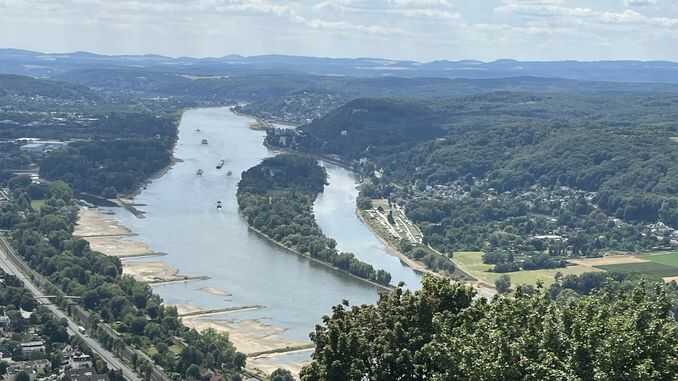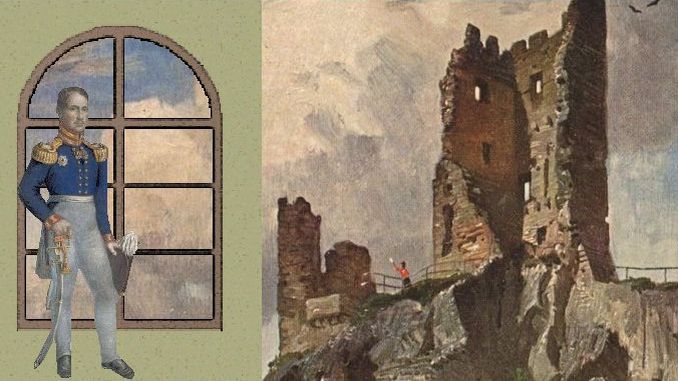
Mount Drachenfels (321 m) certainly is the most famous hill in the Siebengebirge. It has inspired poets such as Lord Byron and Heinrich Heine, and today it attracts countless visitors every year. The view across the Rhine Valley is spectacular.
The skyline of Drachenfels and Wolkenburg is a postcard motive. When you take a boat trip on the Rhine or travel by train between Cologne and Frankfurt, you will have a wonderful view of the Drachenfels and the Siebengebirge mountains from Bonn-Bad Godesberg on the left side of the Rhine or Bad Honnef and Königswinter on the right side. For many people from our region, Mount Drachenfels is just home.
The way up
The ascent is quite a challenge for non-hikers, yet the beauty of the nature, the birds’ singing when you walk through the Nachtigallental (Nightingale Valley) or the wild forest from Rhöndorf, or the views down when you walk along the Eselsweg more than reward you. From the bus stop at Wintermühlenhof estate, an asphalt path leads up past the Hirschburg castle. Of course, you can also ride on the historic rack railway. The line opened in July 1883, back then it had a steam locomotive and was the first rack railway in Germany at all.

From the Drachenfels plateau, you have a breathtaking view across the Rhine valley, on good days as far as Cologne.
Medieval castle Drachenfels
You can visit the ruin of the medieval castle. It was built in 1140-1167 by the archbishops of Cologne to protect the southern border of their territory. It was a hilltop castle, well protected by its location and bretèches with machicolations. Attackers could hardly bring up heavy siege equipment; they were also exposed to fire arrows and stones.
The burgraves
Around 1225, the first burgrave appeared in historical sources. In 1248, the construction of the Gothic cathedral in Cologne began. As the Drachenfels trachyte was the perfect stone, a deal was made with the burgraves, and they soon made a considerable fortune. Regarding to business, those were good times.
Regarding to the political situation, however, those were difficult times. In the 1280s, the burggraves were involved in the war of the Limburg succession between, among others, Archbishop Siegfried II of Cologne and Duke John I of Brabant. They were defeated in the battle of Worringen 1288 and taken captives. Henceforth, the burgraves were involuntary vassals of the Count of Berg.
Godard, the most famous burgrave
Yet, they got back on their feet. At the end of the Middle Ages we meet the most famous burgrave of Drachenfels, Godart (1388-1428). An anecdote says that he wore a beautiful ring – with a piece of trachyte from the Drachenfels! However, Godart did not live in the castle, but in a comfortable and heated town apartment in Königswinter.
The end of the castle
A hundred years later, the Thirty Years’ War was raging in Europe, those years were terrible. In 1633, first the Swedes and then the Spaniards occupied the castle. In 1642, the Archbishop of Cologne had what was left of it destroyed. The time of castles was over.
 Detailed article
Detailed article
Read more about Drachenfels Castle and the burgraves in the chapter on castle ruins:
Drachenfels Castle
Roman quarries
With so much Rhine romanticism, you may forget that Mount Drachenfels in the Siebengebirge has gone through an eventful history. Already the Romans had gained trachyte from quarries on the Drachenfels: large quantities of stones were extracted transported northwards. In the Roman cities of Bonn and Cologne, even in Xanten and Nijmegen stones from the Drachenfels were used. In the Middle Ages, the quarries continued, and large parts of the cathedral in Cologne were built with stones from the Seven Mountains.
Romanticism discovers the Rhine
After the victory over Napoleon, the end of decades of war, it was possible to travel again. British travelers in particular discovered the Rhine Valley. In 1816 Lord Byron dedicated a poem to the Drachenfels, “the castled crag of Drachenfels”. The romanticists among the poets and painters loved the narrow Middle Rhine Valley with its numerous castle ruins.
But not only they, Crown Prince Frederick William of Prussia also came. He visited the Drachenfels twice in those years, in 1815 and 1817, which would soon turn out to be a stroke of luck.

Save the Drachenfels!
Reopening of the quarries
In 1823, repair work began on Cologne Cathedral. The masonry wanted trachyte from the Drachenfels again, and the local stonemasons from Königswinter stonemasons wanted to do business with them right away. Many people, however, locals, Prussian officials and even the crown prince, wanted to protect Mount Drachenfels and the medieval castle ruin. Years of embittered confrontations in the media and in court followed. In 1829, the Prussian Ministry of the Interior ordered the suspension of all quarrying, but the confrontations continued until 1836, when the Prussian state bought the mountain top.
 German names
German names
Drachenfels, masculine in German, Dragon’s Rock. This name probably refers to the old legend of Siegfried the dragon slayer, who killed the dragon here. The Nibelungenlied, however, doesn’t give any details about the site of the dragon fight.

Be the first to comment